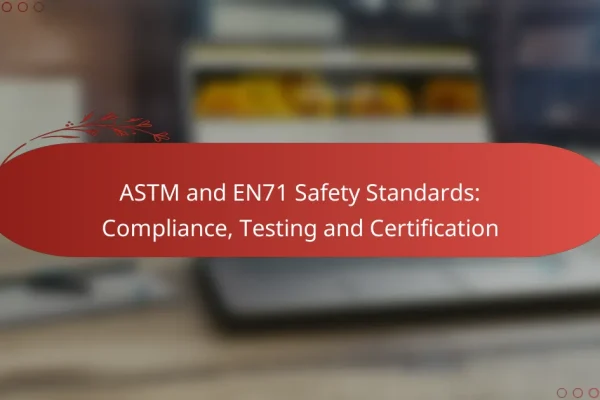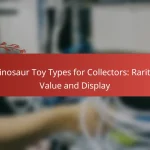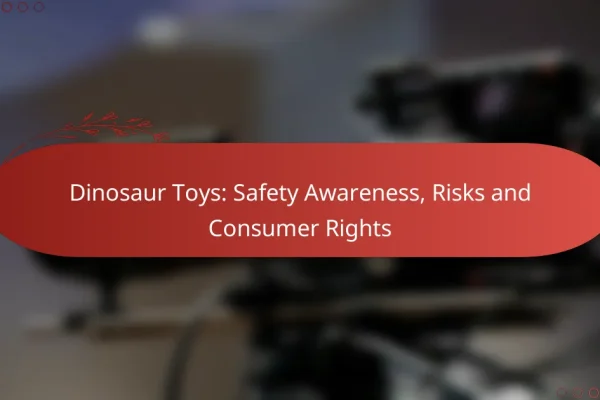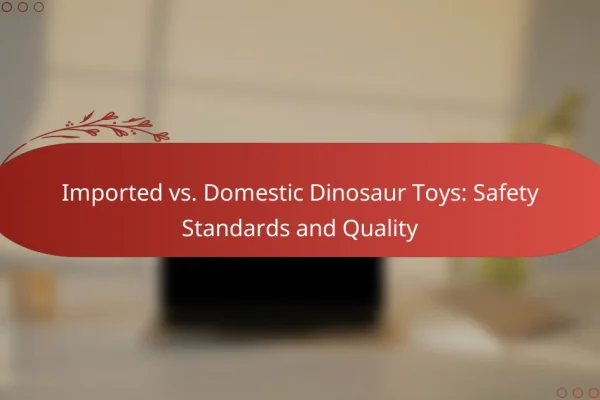What are the safety standards for dinosaur toys in the US?
In the US, dinosaur toys must adhere to specific safety standards to ensure they are safe for children. These standards include compliance with ASTM F963 and regulations set by the CPSC, focusing on material safety and overall design integrity.
ASTM F963 compliance
ASTM F963 is a critical standard that outlines safety requirements for toys, including dinosaur toys. It covers aspects such as mechanical and physical properties, flammability, and toxicology, ensuring that toys do not pose hazards to children.
Manufacturers must test their products to meet these standards, which include checks for small parts that could be choking hazards and ensuring that materials used are non-toxic. Regular updates to the standard reflect new safety concerns and technological advancements.
CPSC regulations
The Consumer Product Safety Commission (CPSC) enforces regulations that govern toy safety, including dinosaur toys. These regulations require manufacturers to report any defects or safety issues and to recall products that do not meet safety standards.
Compliance with CPSC regulations is mandatory, and companies must provide clear labeling and safety warnings on packaging. This ensures that consumers are informed about potential risks associated with the toys.
Material safety guidelines
Material safety guidelines for dinosaur toys focus on the types of materials used in production. Toys should be made from safe, non-toxic materials that do not contain harmful chemicals such as lead or phthalates.
Manufacturers often conduct tests to verify that materials comply with safety standards. Parents should look for certifications or labels indicating that the toys meet safety guidelines, ensuring a safer play experience for children.
How to choose safe dinosaur toys for children?
To choose safe dinosaur toys for children, prioritize age-appropriate designs, non-toxic materials, and durability to prevent choking hazards. Always check for safety certifications and read labels to ensure compliance with safety standards.
Age-appropriate designs
Age-appropriate designs are crucial for ensuring that dinosaur toys are suitable for the developmental stage of your child. Toys should match the child’s age group, as younger children may require simpler shapes and sizes to avoid choking risks. Look for toys labeled for specific age ranges, typically found on packaging.
For instance, toys designed for toddlers often feature larger pieces that are easier to grasp and manipulate. In contrast, toys for older children can include more intricate designs and smaller parts that encourage imaginative play.
Non-toxic materials
Choosing dinosaur toys made from non-toxic materials is essential for children’s safety. Look for toys that are free from harmful chemicals such as phthalates, lead, and BPA. Many manufacturers now provide information about the materials used, so check for labels indicating compliance with safety standards.
Common safe materials include high-quality plastics, wood, and natural rubber. Certifications such as ASTM or EN71 can also provide assurance that the toy meets safety regulations in your region.
Durability and choking hazards
Durability is a key factor in preventing choking hazards with dinosaur toys. Ensure that the toys are sturdy enough to withstand rough play, as broken pieces can pose a risk. Check for any small parts that could detach and become choking hazards, especially for younger children.
A good practice is to perform a small parts test: if a toy’s component can fit through a toilet paper roll, it may be too small for young children. Regularly inspect toys for wear and tear, and replace any damaged items promptly to maintain safety.
What are the common safety certifications for dinosaur toys?
Common safety certifications for dinosaur toys include CE marking, EN71 compliance, and ISO 8124 standards. These certifications ensure that toys meet specific safety requirements to protect children from potential hazards.
CE marking
CE marking indicates that a dinosaur toy complies with European Union safety standards. It signifies that the product has undergone necessary assessments and meets health, safety, and environmental protection requirements.
When purchasing toys with CE marking, look for additional documentation that confirms compliance with relevant directives. This helps ensure that the toy is safe for children and free from harmful substances.
EN71 compliance
EN71 compliance refers to a set of European safety standards specifically for toys, including dinosaur toys. These standards cover various aspects such as mechanical and physical properties, flammability, and chemical safety.
Manufacturers must test their products against EN71 standards to ensure they do not pose choking hazards or other risks. Always check for the EN71 mark on packaging to confirm compliance.
ISO 8124 standards
ISO 8124 standards are international safety guidelines for toys, including those designed for young children. These standards focus on ensuring that toys are safe in terms of design, materials, and overall construction.
When selecting dinosaur toys, look for those that adhere to ISO 8124 standards. This can help you avoid toys that may have sharp edges, small parts, or toxic materials, ensuring a safer play experience for children.
How do dinosaur toy manufacturers ensure safety?
Dinosaur toy manufacturers ensure safety through rigorous quality control, third-party testing, and regular safety audits. These processes help identify potential hazards and ensure compliance with safety standards, providing peace of mind for parents and guardians.
Quality control processes
Quality control processes involve systematic checks at various stages of production. Manufacturers often implement inspections during material selection, assembly, and final packaging to detect defects early. This proactive approach minimizes the risk of unsafe toys reaching consumers.
Common practices include visual inspections, functional testing, and the use of standardized checklists. For example, toys are tested for sharp edges, small parts, and toxic materials to ensure they meet safety regulations.
Third-party testing
Third-party testing involves independent laboratories evaluating toys for safety compliance. These labs assess products against established standards, such as ASTM F963 in the United States or EN71 in Europe, which outline safety requirements for toys.
Manufacturers often submit samples of their dinosaur toys for testing, which can include assessments for choking hazards, flammability, and chemical content. This unbiased evaluation helps ensure that toys are safe for children before they hit the market.
Regular safety audits
Regular safety audits are essential for maintaining high safety standards throughout the production process. These audits can be internal or conducted by external organizations and typically review quality control practices, testing protocols, and compliance with safety regulations.
During an audit, manufacturers may examine records of past tests, inspect production facilities, and assess employee training on safety procedures. Consistent audits help identify areas for improvement and ensure ongoing adherence to safety standards, ultimately protecting children who play with these toys.
What are the risks associated with unsafe dinosaur toys?
Unsafe dinosaur toys can pose several risks, including choking hazards, exposure to toxic materials, and injuries from sharp edges. Understanding these risks is crucial for ensuring the safety of children during playtime.
Choking hazards
Choking hazards are a significant concern with dinosaur toys, especially those with small parts that can easily detach. Toys designed for younger children should not contain pieces smaller than 4 centimeters, as these can pose a choking risk.
Parents should regularly inspect toys for wear and tear, ensuring that no small parts are loose or missing. Opting for toys that are labeled as “choke-proof” or meet safety standards can help mitigate these risks.
Toxic materials exposure
Exposure to toxic materials is another risk associated with some dinosaur toys, particularly those made from low-quality plastics. Chemicals such as phthalates and lead can be harmful, especially to young children who may put toys in their mouths.
To avoid toxic exposure, look for toys that comply with safety regulations, such as the ASTM F963 standard in the United States or EN71 in Europe. Choosing toys made from non-toxic, BPA-free materials can further enhance safety.
Injury from sharp edges
Injury from sharp edges is a potential risk with poorly manufactured dinosaur toys. Toys with jagged edges or protruding parts can cause cuts or scrapes, particularly if children are playing roughly.
When selecting dinosaur toys, inspect them for any sharp edges and ensure they are made from smooth materials. Avoid toys with intricate designs that may have hidden sharp points, and always supervise young children during play to prevent accidents.
What should parents look for in dinosaur toy packaging?
Parents should look for clear safety information and age recommendations on dinosaur toy packaging. These details help ensure the toys are safe for their children and appropriate for their developmental stage.
Safety labels
Safety labels on dinosaur toys indicate compliance with relevant safety standards, such as ASTM F963 in the United States or EN71 in Europe. These labels assure parents that the toys have been tested for hazards like choking, sharp edges, and toxic materials.
Look for labels that specify non-toxic materials and any certifications from recognized safety organizations. If a toy lacks these labels, it may not meet safety requirements, making it a risky choice for children.
Age recommendations
Age recommendations on dinosaur toy packaging guide parents in selecting toys that match their child’s developmental abilities. These recommendations typically range from 0-3 years for soft toys to 6+ years for more complex models that may include small parts.
Choosing toys that align with these age guidelines helps prevent accidents, such as choking hazards for younger children. Always consider your child’s maturity and play habits alongside the age recommendations to ensure safe play experiences.












